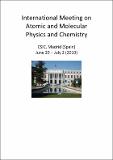Por favor, use este identificador para citar o enlazar a este item:
http://hdl.handle.net/10261/92423COMPARTIR / EXPORTAR:
 SHARE
BASE SHARE
BASE
|
|
| Visualizar otros formatos: MARC | Dublin Core | RDF | ORE | MODS | METS | DIDL | DATACITE | |

| Título: | Nonadiabatic dynamics in O2+O2 collisions |
Autor: | Dayou, F. CSIC; Hernández, Marta I. CSIC ORCID; Campos-Martínez, José CSIC ORCID; Hernández-Lamoneda, Ramón | Fecha de publicación: | 29-jun-2010 | Editor: | CSIC - Instituto de Física Fundamental (IFF) | Citación: | IMAMPC 2010, I International Meeting on Atomic and Molecualr Physics and Chemistry | Resumen: | The energy transfer by collisions involving the ground and excited species of molecular oxygen plays a crucial role in the chemistry of the upper Earth¿s atmosphere. The specificities of molecular oxygen (a stable radical in its ground X 3¿g - state, with two low-lying excited states a 1¿g and b 1¿g +) provide appropriate conditions for a rich variety of collision-induced energy transfer mechanisms. Experimentally, the rate coefficients measured for the collisional removal of O2(X 3¿g -, high-v),O2(a 1¿g, low-v) and O2(b 1¿g +, low-v) by O2 are fast and show peculiar features which cannot be explained by simple vibrational cascadings. The strong changes observed in the rate coefficients between adjacent vibrational levels suggest that near-resonant processes, involving electronic energy transfers, should dominate the removal processes. However, the final state distribution could not be probed experimentally, and theoretical studies are needed to unveil the underlying mechanisms. By resorting to a reduced dimensionality model of the dimer, together with ab initio methods and quantum dynamics calculations, we have shown that intra-molecular electronic energy transfers, O2(X 3¿g -, v) + O2 ¿ O2(a 1¿g, v¿) + O2, O2(X 3¿g -, v) + O2 ¿ O2(b 1¿g +, v¿) + O2, mediated by spin-orbit couplings between the dimer states, were able to mimic the sharp changes observed in the measured collisional removal rate coefficients for O2(X 3¿g -,v ¿ 26). In a recent study, we have also addressed the problem of inter-molecular electronic energy transfer, O2(b 1¿g+, v) + O2(X 3¿g-, v=0) ¿ O2(X 3¿g -, v¿) + O2(b 1¿g+, v=0), mediated by nonadiabatic radial couplings between the dimer states. It is found that the multidimensional nonadiabatic couplings can be predicted with high accuracy, compared to the ab initio results, by using analytical forms only depending on a reduced set of adiabatic energy terms. The results of quantum dynamics calculations for the removal of O2(b 1¿g +, v ¿ 3) are found qualitatively consistent with the experimental observations. | Descripción: | I International Meeting on Atomic and Molecualr Physics and Chemistry, Madrid, June 29-July 2, 2010. http://fama.iff.csic.es/con/imampc-2010/ | URI: | http://hdl.handle.net/10261/92423 |
| Aparece en las colecciones: | (CFMAC-IFF) Comunicaciones congresos |
Ficheros en este ítem:
| Fichero | Descripción | Tamaño | Formato | |
|---|---|---|---|---|
| FDayou.pdf | 228,05 kB | Adobe PDF |  Visualizar/Abrir |
CORE Recommender
Page view(s)
320
checked on 26-abr-2024
Download(s)
90
checked on 26-abr-2024
Google ScholarTM
Check
NOTA: Los ítems de Digital.CSIC están protegidos por copyright, con todos los derechos reservados, a menos que se indique lo contrario.
